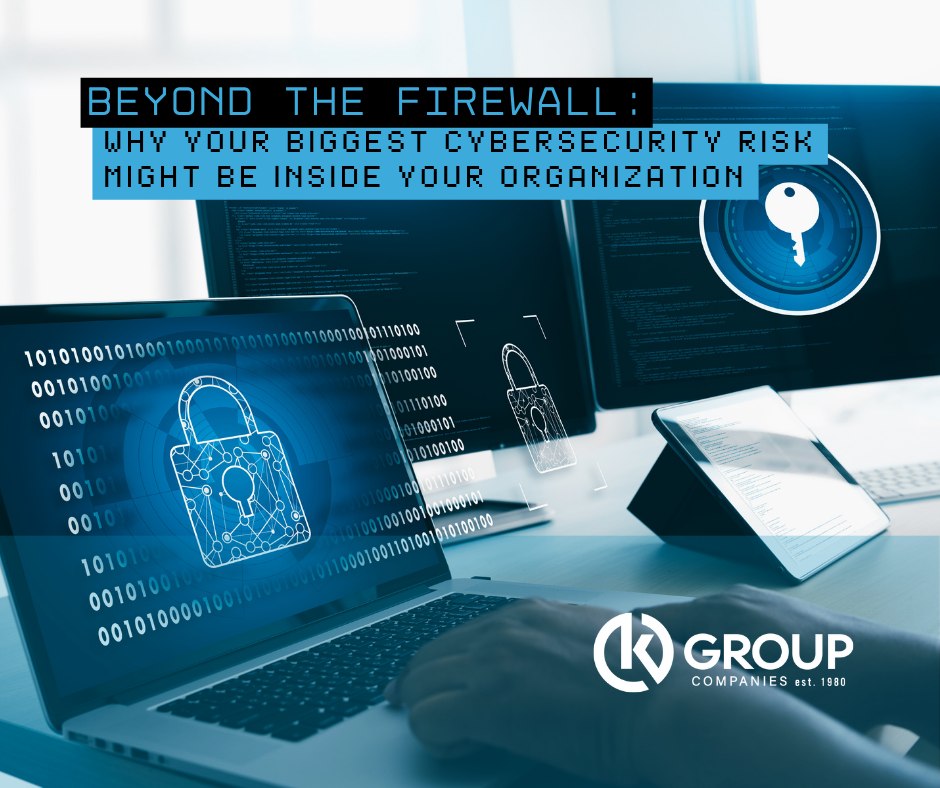Beyond the Firewall: Why Your Biggest Cybersecurity Risk Might Be Inside Your Organization
For years, cybersecurity conversations have zeroed in on outside threats: hackers, zero-day exploits, and state-sponsored
attacks. Those risks are real and demand strong defenses, but here’s what often gets missed: the biggest vulnerabilities usually come from inside the organization. After four decades in tech services, we’ve seen the same pattern over and over where end-user actions (whether accidental or intentional), are now the leading doorway for cyberattacks.
the biggest vulnerabilities usually come from inside the organization. After four decades in tech services, we’ve seen the same pattern over and over where end-user actions (whether accidental or intentional), are now the leading doorway for cyberattacks.
The Human Element: The Unsung Vulnerability
While we invest heavily in perimeter defenses, advanced threat detection, and incident response, the human factor remains the most unpredictable variable in the security equation. Phishing attacks, weak password practices, social engineering, and even simple misconfigurations can open doors that no firewall can anticipate. It’s not about blame; it’s about understanding the reality that even the most well-meaning employee can inadvertently create a critical security gap.
Shifting the Focus: From External Battles to Internal Fortification
This isn't to say external threats aren't a concern. They are. But a truly comprehensive security posture demands an equal, if not greater, emphasis on internal risk management. This includes:
- Continuous Training & Awareness: Regular engaging, and relevant cybersecurity training is non-negotiable. It's about empowering employees with the knowledge to recognize threats and act as the first line of defense.
- Strong Policy Enforcement: Clear, concise, and consistently enforced policies around password hygiene, data handling, device usage, and reporting suspicious activity are crucial.
- Proactive Internal Audits: Regularly assessing internal vulnerabilities, from system access permissions to software update compliance, helps identify and remediate weaknesses before they can be exploited.
- Embracing a Culture of Security: Security isn't just an IT department's job; it's everyone's responsibility. Fostering an environment where reporting potential issues is encouraged, not feared, is paramount.
K Group's Approach: Integrating People and Technology for True Resilience
As Trusted Integrators of Complete Technology Ecosystems, we believe that the strongest solutions are built on a foundation of genuine human connection. Our approach extends beyond deploying technology; we focus on integrating robust security practices with your operational culture. We help break down the silos between your technology and your people, ensuring that every individual understands their role in protecting your organization's most valuable assets. By raising your Operational Maturity Level (OML) in cybersecurity, we help you transform potential human vulnerabilities into powerful lines of defense.
Cyber threats aren’t slowing down, and neither should your strategy. Overlooking internal risks is one of the biggest mistakes organizations make. The truth? Most breaches start inside. Shift from reacting to attacks to building a culture where every employee plays a role in defense. When your team understands their impact, they become your strongest security asset.
Does your organization prioritize internal cybersecurity education and policy? To learn how K Group can help strengthen your human firewall and elevate your security OML, contact us for a consultation.

Q: Why focus on internal cybersecurity risks when external threats are so prevalent?
A: External threats like hackers and malware are real, but research and decades of experience show that most breaches start inside the organization—often unintentionally. Employees clicking phishing links, using weak passwords, or misconfiguring systems can create vulnerabilities no firewall can block.
Q: What are the most common internal cybersecurity risks?
A: The top risks include:
- Phishing attacks targeting employees
- Weak or reused passwords
- Social engineering tactics
- Accidental data sharing or misconfigurations
Q: How can organizations reduce internal cybersecurity risks?
A: A strong internal security posture includes:
- Continuous Training & Awareness: Regular, engaging sessions to help employees recognize threats.
- Clear Policy Enforcement: Simple, consistent rules for passwords, data handling, and reporting suspicious activity.
- Proactive Internal Audits: Regular checks on access permissions and software compliance.
- Security-First Culture: Encourage reporting without fear of blame.
Q: Is this about blaming employees?
A: Absolutely not. It’s about empowering employees to be the first line of defense. Mistakes happen, but with the right training and culture, those mistakes can be minimized.
Q: How does K Group help organizations strengthen internal security?
A: We integrate people and technology to raise your Operational Maturity Level (OML) in cybersecurity. Our approach combines robust security tools with cultural alignment, ensuring every team member understands their role in protecting your digital assets.
Q: Where can I learn more or get help?
A: Visit kgroupcompanies.com or contact us for a consultation on building your human firewall.